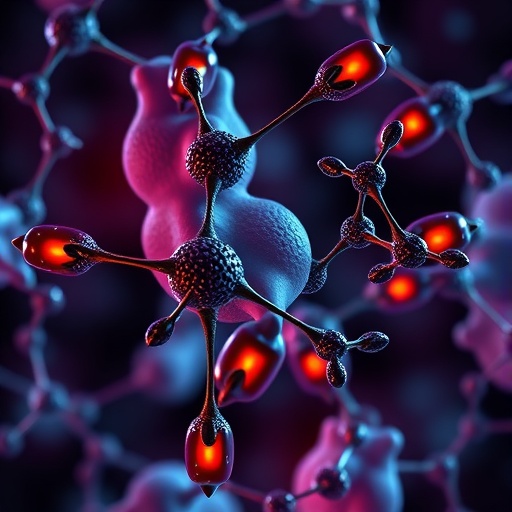A groundbreaking study published in Nature has unveiled a novel molecular mechanism linking mitochondrial DNA (mtDNA) instability to inflammation, implicating the incorporation of ribonucleotides into mtDNA as a key driver. This discovery sheds light on intricate processes underpinning cellular senescence and age-related inflammation, heralding new therapeutic avenues for conditions associated with chronic inflammation.
Mitochondria, often described as the powerhouses of the cell, house their own genetic material critical for cellular energy metabolism and signaling. Unlike nuclear DNA, mitochondrial DNA is replicated by machinery operating independently of the cell cycle, making its fidelity essential for maintaining cellular homeostasis. The research team explored how the imbalance between ribonucleotide triphosphates (rNTPs) and deoxyribonucleotide triphosphates (dNTPs) influences mtDNA integrity and consequent immune responses.
Central to this study is the enzyme ribonucleotide reductase (RNR), responsible for reducing rNTPs into dNTPs, thus providing the building blocks for DNA synthesis. RNR is composed of RRM1 and RRM2 subunits, with RRM2 expression tightly regulated by the cell cycle and notably diminished in senescent cells. This downregulation leads to depleted dNTP pools, creating a skewed nucleotide ratio favoring rNTPs, which are aberrantly incorporated into mtDNA during replication.
The researchers induced senescence in human lung fibroblasts (IMR90 cells) using ionizing radiation and chemotherapeutic agents to mimic therapy-induced senescence. These senescent cells showed a higher rNTP/dNTP ratio and increased ribonucleotide incorporation into mtDNA, as demonstrated through alkaline gel electrophoresis sensitive to RNase H2 treatment. Such incorporation compromises mtDNA stability and primes the cell for mtDNA release into the cytosol, a potent trigger for the senescence-associated secretory phenotype (SASP), a pro-inflammatory state implicated in aging and disease.
Intriguingly, supplementation of senescent cells with deoxyribonucleosides reversed several pathological features. While it did not prevent the onset of senescence itself—verified through senescence-associated β-galactosidase activity—it notably reduced cytosolic mtDNA accumulation and the ribonucleotide load within the mitochondrial genome. This biochemical intervention concurrently suppressed the expression of key inflammatory SASP genes, delineating a causal relationship where dNTP restoration mitigates inflammatory signaling by maintaining mtDNA integrity.
The link between ribonucleotide incorporation and inflammation extends beyond cell culture models. Examination of aged murine tissues—including kidney, liver, heart, and spleen—revealed a consistent elevation in rNTP/dNTP ratios relative to young counterparts. Correspondingly, mtDNA isolated from aged tissues was more susceptible to alkali and RNase H2-mediated cleavage, confirming increased ribonucleotide incorporation with natural aging. These findings substantiate that altered nucleotide metabolism and aberrant mtDNA composition are hallmarks of aging in vivo.
A pivotal insight emerges from understanding how cell cycle arrest, characteristic of senescence, indirectly influences mtDNA replication fidelity. Since mtDNA replication is cell cycle independent, the depletion of dNTP pools in non-dividing cells fosters a nucleotide environment conducive to rNMP incorporation. This nuance underscores the complexity of intracellular nucleotide dynamics and highlights mitochondrial genome vulnerability during aging and stress.
Moreover, the study illuminates the mechanistic pathway fueling sterile inflammation—a hallmark of many chronic diseases. Cytosolic leakage of damaged mtDNA triggers innate immune sensors that activate inflammatory cascades. By demonstrating that elevated rNMP content precedes and possibly facilitates mtDNA release, this research identifies a molecular target that could be modulated to alleviate inflammation without interfering with the essential senescent growth arrest.
The therapeutic implications are profound. Targeting nucleotide metabolism through deoxyribonucleoside supplementation or by modulating RNR activity offers a potential strategy to preserve mitochondrial genome integrity, reduce deleterious inflammation, and possibly ameliorate age-associated pathologies. Such interventions could complement existing approaches aiming to manipulate senescence and inflammatory states in aging tissues.
In addition to aging, these findings bear relevance in clinical contexts where DNA damage and repair pathways are perturbed, such as cancer therapy. The observation that doxorubicin and decitabine-induced senescence replicates the increased ribonucleotide incorporation and inflammatory phenotype invites further investigations into mitigating side effects of genotoxic treatments.
Future directions will likely explore the enzyme systems responsible for ribonucleotide excision repair within mitochondria and their regulation. Understanding whether enhancing repair capacity can counteract accumulated rNMPs holds promise in developing finely tuned interventions to maintain mitochondrial health across the lifespan.
This study represents a significant leap in mitochondrial biology and inflammatory research, providing a molecular framework linking nucleotide pool imbalance, mitochondrial DNA integrity, and inflammatory signaling. As the global population ages, unraveling such intricate connections will be paramount in designing therapies to improve healthspan and mitigate chronic inflammatory diseases.
Subject of Research: Mechanisms of ribonucleotide incorporation into mitochondrial DNA and its role in driving inflammation and senescence-associated secretory phenotype.
Article Title: Ribonucleotide incorporation into mitochondrial DNA drives inflammation.
Article References:
Bahat, A., Milenkovic, D., Cors, E. et al. Ribonucleotide incorporation into mitochondrial DNA drives inflammation.
Nature (2025). https://doi.org/10.1038/s41586-025-09541-7




